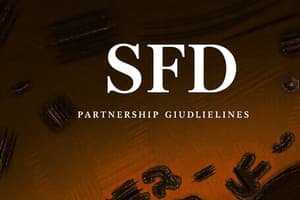Podcast
Questions and Answers
What can a brand represent?
What can a brand represent?
- An identity, a promise, and customer perceptions (correct)
- Only tangible products
- A legal contract between companies
- A method for advertising
Which element primarily contributes to visual recognition of a brand?
Which element primarily contributes to visual recognition of a brand?
- Brand loyalty
- The logo (correct)
- Product pricing
- Customer service
What do shared values among consumers and brands primarily build?
What do shared values among consumers and brands primarily build?
- Market competition
- Loyalty (correct)
- Product discounts
- Brand recognition
What is the significance of experiences and stories in branding?
What is the significance of experiences and stories in branding?
Which of the following best describes brand management?
Which of the following best describes brand management?
What role does the visual identity play in branding?
What role does the visual identity play in branding?
What is NOT a characteristic of a brand as per the discussed concepts?
What is NOT a characteristic of a brand as per the discussed concepts?
How do 'colours, type or smell' affect branding?
How do 'colours, type or smell' affect branding?
What is a characteristic of tangible brands?
What is a characteristic of tangible brands?
What do intangible brands primarily depend on to engage their audience?
What do intangible brands primarily depend on to engage their audience?
How do basic needs differ from complex needs when considering brands?
How do basic needs differ from complex needs when considering brands?
Which statement is true regarding brand management for tangible brands?
Which statement is true regarding brand management for tangible brands?
What is a key aspect of managing an intangible brand?
What is a key aspect of managing an intangible brand?
What might be a reason for a brand to have intangible elements?
What might be a reason for a brand to have intangible elements?
In what way are objective needs perceived in brand management?
In what way are objective needs perceived in brand management?
Which is a necessary focus for brands managing complex needs?
Which is a necessary focus for brands managing complex needs?
What is essential for a brand to be recognized in a competitive market?
What is essential for a brand to be recognized in a competitive market?
Which aspect helps a brand create stronger relationships with its audience?
Which aspect helps a brand create stronger relationships with its audience?
What do product brands typically depend on to differentiate themselves?
What do product brands typically depend on to differentiate themselves?
In what scenario can experience be a key factor for brands?
In what scenario can experience be a key factor for brands?
What is the impact of enhancing differential values in a brand?
What is the impact of enhancing differential values in a brand?
What can strengthen the bond between a brand and its clients?
What can strengthen the bond between a brand and its clients?
What is a characteristic of product brands mentioned in the content?
What is a characteristic of product brands mentioned in the content?
What underlying theme is suggested when a brand is about ideas or ideals?
What underlying theme is suggested when a brand is about ideas or ideals?
What is the first step in the strategic planning process according to the content?
What is the first step in the strategic planning process according to the content?
Why is aligning the brand’s definition with the strategic platform important?
Why is aligning the brand’s definition with the strategic platform important?
Which element is not mentioned as part of the strategic planning process?
Which element is not mentioned as part of the strategic planning process?
Creating a community around a brand primarily aims to achieve what?
Creating a community around a brand primarily aims to achieve what?
What does KPI stand for in the context of strategic planning?
What does KPI stand for in the context of strategic planning?
Which of the following represents a possible outcome of strategic planning?
Which of the following represents a possible outcome of strategic planning?
In strategic planning, what is meant by 'business ambition'?
In strategic planning, what is meant by 'business ambition'?
What role does analyzing consumer insights play in strategic planning?
What role does analyzing consumer insights play in strategic planning?
What is the primary function of brand strategy as mentioned?
What is the primary function of brand strategy as mentioned?
Which aspect is NOT a part of developing brand strategy?
Which aspect is NOT a part of developing brand strategy?
What does the term 'brand culture' refer to?
What does the term 'brand culture' refer to?
Which of the following is part of the tools used in brand strategy?
Which of the following is part of the tools used in brand strategy?
The initial stage of brand strategy development focuses on which aspect?
The initial stage of brand strategy development focuses on which aspect?
Which of the following factors is NOT defined as essential in determining brand strategy?
Which of the following factors is NOT defined as essential in determining brand strategy?
How does an organization support the internalization of brand principles?
How does an organization support the internalization of brand principles?
What is the focus of the 'operations' aspect in brand strategy?
What is the focus of the 'operations' aspect in brand strategy?
What does the brand idea represent?
What does the brand idea represent?
What do brand ingredients refer to?
What do brand ingredients refer to?
Which of the following best describes brand personality?
Which of the following best describes brand personality?
What do brand values determine?
What do brand values determine?
How are benefits perceived by consumers structured?
How are benefits perceived by consumers structured?
What role do differentiating ideas play in brand management?
What role do differentiating ideas play in brand management?
What is indicated by the term 'brand DNA'?
What is indicated by the term 'brand DNA'?
What is the essence of a brand?
What is the essence of a brand?
Flashcards
Tangible Brands
Tangible Brands
Brands based on physical attributes like taste, shape, and color.
Intangible Brands
Intangible Brands
Brands built on abstract values and concepts.
Brand Identity
Brand Identity
The unique image and characteristics of a brand.
Objective Needs
Objective Needs
Signup and view all the flashcards
Subjective Needs
Subjective Needs
Signup and view all the flashcards
Complex Needs
Complex Needs
Signup and view all the flashcards
Basic Needs
Basic Needs
Signup and view all the flashcards
Managing a Brand
Managing a Brand
Signup and view all the flashcards
Brand
Brand
Signup and view all the flashcards
Brand Management
Brand Management
Signup and view all the flashcards
Visual Identity
Visual Identity
Signup and view all the flashcards
Brand - Customer Perception
Brand - Customer Perception
Signup and view all the flashcards
Logo
Logo
Signup and view all the flashcards
Brand Promise
Brand Promise
Signup and view all the flashcards
Brand Experiences
Brand Experiences
Signup and view all the flashcards
Brand Value
Brand Value
Signup and view all the flashcards
Product Brand
Product Brand
Signup and view all the flashcards
Competitive Market
Competitive Market
Signup and view all the flashcards
Tangible Products
Tangible Products
Signup and view all the flashcards
Visual and Verbal Identity
Visual and Verbal Identity
Signup and view all the flashcards
Strategic Planning
Strategic Planning
Signup and view all the flashcards
Brand Definition
Brand Definition
Signup and view all the flashcards
Business Objectives
Business Objectives
Signup and view all the flashcards
Key Findings
Key Findings
Signup and view all the flashcards
Strategic Platform
Strategic Platform
Signup and view all the flashcards
Actions and Tactics
Actions and Tactics
Signup and view all the flashcards
Analysis and Evaluation
Analysis and Evaluation
Signup and view all the flashcards
Brand Strategy
Brand Strategy
Signup and view all the flashcards
Brand Culture
Brand Culture
Signup and view all the flashcards
Brand DNA
Brand DNA
Signup and view all the flashcards
Brand Tools & Operations
Brand Tools & Operations
Signup and view all the flashcards
Brand Purpose
Brand Purpose
Signup and view all the flashcards
Brand Manifesto
Brand Manifesto
Signup and view all the flashcards
Brand Platform
Brand Platform
Signup and view all the flashcards
Brand Essence
Brand Essence
Signup and view all the flashcards
Brand Personality
Brand Personality
Signup and view all the flashcards
Brand Attributes
Brand Attributes
Signup and view all the flashcards
Brand Differentiation
Brand Differentiation
Signup and view all the flashcards
Brand Benefits
Brand Benefits
Signup and view all the flashcards
Study Notes
Introduction to Brand Management (Objectives)
- Defining branding and differentiating it from related concepts like mark, brand identity.
- Identifying the stages in branding history.
- Understanding the evolution of branding as a key asset for modern companies.
- Listing the main purposes of brands depending on their type and market.
Introduction to Brand Management (Contents)
- Definitions essential concepts of brand, branding, and brand identity.
- Branding in today's world (transition from product to company brands).
- Types of Brands and their architecture.
- A short history of branding (from pre-historic cave paintings, to ancient calligraphy, to the renaissance period, and the industrial revolution).
Studying That Suits You
Use AI to generate personalized quizzes and flashcards to suit your learning preferences.




